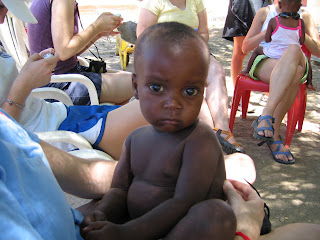It’s hard to believe that the shortest day of the year has come and gone (longest day for those of you in the Northern Hemisphere). Time is passing quickly and we have been keeping very busy. As you’ve read the last three weeks have been filled with trips to the bush with our out of town guests – Central Kalahari Game Reserve to scout a new route for the trans-Kalahari trip in August, Moremi Game Reserve twice to find the new mobile operators campsites, Savuti to see the channel filled with water (hasn’t had water in it since the 1980s - see photo below with me looking at the channel from the Rock Painting Hill), Kgwebe Hills to visit a new lodge under development by friends where Paul wants to market astronomy safaris, Meno a Kwena tented camp for a star show, and back to Kgwebe Hills to transport some investors for a new copper mine under construction. If you add to that a couple of flights over the Delta (one scenic flight with our guests on their last day before they departed and the other with the Deputy Permanent Secretary to survey the water situation and see the road and bridge conditions), no wonder I feel busy.
The flights revealed the massive amounts of water over the entire region. With the buffalo fence completely under water in spots (the fence erected by the government in the early 1980s to separate the wild life from the cattle), the animals have free range of movement (if they can get through all the water). Where there used to be well used roads there are now lakes (see the photo below of the water taking over the road). Bridges have submerged and whole areas of the Delta are completely cut off from traffic. It is quite impressive. Paul was asked to fly with the government official to represent the mobile safari sector as he knows the area quite well and could take photographs for him to use in a presentation to the President. I just tagged along for the day.
As is typical on these tiny flights, I am put in the back due to weight distribution. I try to mentally convince myself that I’m fine, as I’ve never actually thrown up on a plane, but as we “buzzed” the game scouts’ camp up in Savuti to signal our arrival (one big radically tilted loop over their camp), I turned a little green and was really happy when we landed so I could get my feet on the ground for a few minutes. Fortunately, when we took off again I wasn’t too queasy and my continued self-reassurance worked as I made it through the day without barfing!
Winter arrived last Monday night while we were at Meno a Kwena doing a star show (see photo below of me lounging outside the luxury tent). Fortunately, it didn’t arrive until the middle of the night so Paul’s show was not too cold. It came in around 2 AM with some big winds and has stayed since. We are now getting close to freezing temperatures every night and in the 70s in the day. The dip in temps coupled with the frolicking elephants in the river outside our tent kept us up a bit that night but the elephants seemed like they were having such a good time, it was hard to be annoyed by them. Splash! Splash! Dip! Spray! Drink! Drink! Drink!
Working with the copper mine folks has been fascinating. As you may know, mining is big business in this region of the world and there is some exploratory mining for copper taking place near the Kgwebe Hills lodge I mentioned earlier. The trays of core samples (ten or so cylinders of earth to a metal tray) stacked 10 high spread across two expansive fields look somewhat like a grave yard. While the Ngami Times recently reported a “successful” EIA – Environmental Impact Assessment for the project the three “benefits” seem to me far from beneficial to the community. First, the article pointed out that new waste piles will be created (is this good?). Second, that the open pit mines may be a hazard to the local cattle (I envision them casually chewing, not paying attention and...falling into the pits!). And finally, that migrant laborers will come to the area to work at the mine and production plant (again, is this good? With migrant labor comes the spread of diseases like HIV). Anyway, I try to keep my mouth shut. The safari company's job is to transport the investors down for a visit (not to raise moral and ethical questions about the venture).
My birthday on Friday was lots of fun and, although I resisted Facebook for some time, it was so nice to get intercontinental birthday wishes all day long. This year we even managed to find a yummy chocolate cake (last year’s failed attempt at ice cream, which had melted and re-frozen leaving only sweet sludge at the bottom, still hovers in our minds).
With just two months left before I return to the states I’m now turning my attention more concertedly to preparing for the fall semester and the courses I’ll be teaching. I’ve been reading a lot (as always) but need to start updating some lectures…I’d rather be in the bush!
PS: Oh yeah, almost forgot to mention that I saw Prince William at a restaurant near the airport the other day. He was in town for a fund raiser. He and his brother Harry are regular visitors to Botswana. He looks just like his Mum!
















